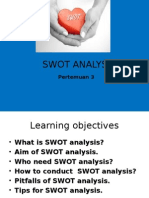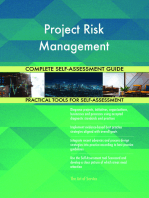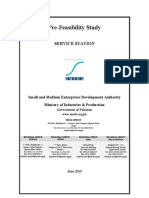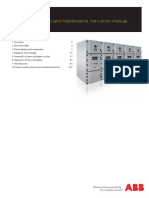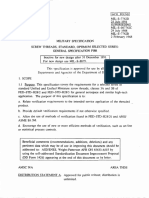Lecture SWOT Analysis 265
Uploaded by
Sh Mati ElahiLecture SWOT Analysis 265
Uploaded by
Sh Mati ElahiSWOT analysis
SWOT Analysis, is a strategic planning tool used to evaluate the Strengths, Weaknesses, Opportunities, and Threats involved in a project or in a business venture. It involves specifying the objective of the business venture or project and identifying the internal and external factors that are favorable and unfavorable to achieving that objective. The technique is credited to Albert Humphrey, who led a research project at Stanford University in the 1960s and 1970s using data from the Fortune 500 companies.
Strategic and Creative Use of SWOT Analysis
Strategic Use: Orienting SWOTs to An Objective. --- If SWOT analysis does not start with defining a desired end state or objective, it runs the risk of being useless. A SWOT analysis may be incorporated into the strategic planning model. An example of a strategic planning technique that incorporates an objective-driven SWOT analysis is SCAN analysis. Strategic Planning, including SWOT and SCAN analysis, has been the subject of much research. If a clear objective has been identified, SWOT analysis can be used to help in the pursuit of that objective. In this case, SWOTs are: Strengths: attributes of the organization that are helpful to achieving the objective. Weaknesses: attributes of the organization that are harmful to achieving the objective. Opportunities: external conditions that are helpful to achieving the objective. Threats: external conditions that are harmful to achieving the objective. See the SWOT diagram at the end of topic. Correct identification of SWOTs is essential because subsequent steps in the process of planning for achievement of the selected objective are to be derived from the SWOTs. First, the decision makers have to determine whether the objective is attainable, given the SWOTs. If the objective is NOT attainable a different objective must be selected and the process repeated. Creative Use of SWOTs.--- If, on the other hand, the objective seems attainable, the SWOTs are used as inputs to the creative generation of possible strategies, by asking and answering each of the following four questions, many times: 1. How can we Use each Strength? 2. How can we Stop each Weakness?
3. How can we Exploit each Opportunity? 4. How can we Defend against each Threat? Ideally a cross-functional team or a task force that represents a broad range of perspectives should carry out the SWOT analysis. For example, a SWOT team may include an accountant, a salesperson, an executive manager, an engineer, and an ombudsman.
Internal and external factors
The aim of any SWOT analysis is to identify the key internal and external factors that are important to achieving the objective. SWOT analysis groups key pieces of information into two main categories:
Internal factors - The strengths and weaknesses internal to the organization. External factors - The opportunities and threats presented by the external environment.
The internal factors may be viewed as strengths or weaknesses depending upon their impact on the organization's objectives. What may represent strengths with respect to one objective may be weaknesses for another objective. The factors may include all of the 4P's; as well as personnel, finance, manufacturing capabilities, and so on. The external factors may include macroeconomic matters, technological change, legislation, and sociocultural changes, as well as changes in the marketplace or competitive position. The results are often presented in the form of a matrix. SWOT analysis is just one method of categorization and has its own weaknesses. For example, it may tend to persuade companies to compile lists rather than think about what is really important in achieving objectives. It also presents the resulting lists uncritically and without clear prioritization so that, for example, weak opportunities may appear to balance strong threats. It is prudent not to eliminate too quickly any candidate SWOT entry. The importance of individual SWOTs will be revealed by the value of the strategies it generates. A SWOT item that produces valuable strategies is important. A SWOT item that generates no strategies is not important.
Examples of SWOTs
Strengths and weaknesses
Resources: financial, intellectual, location Customer service
Efficiency Infrastructure Quality Staff Management Price Delivery time Cost Capacity Relationships with customers Brand strength Local language knowledge Ethics principles patents strong brand names good reputation among customers cost advantages from proprietary know-how exclusive access to high grade natural resources favorable access to distribution networks
Opportunities and threats
Political/Legal Market Trends Economic condition Expectations of stakeholders Technology Public expectations Competitors and competitive actions Bad PR Criticism (Editorial) Global Markets
Errors to be avoided
The following errors have been observed in published accounts of SWOT analysis: 1. Conducting a SWOT analysis before defining and agreeing upon an objective (a desired end state). SWOTs should not exist in the abstract. They can exist only with reference to an objective. If the desired end state is not openly defined and agreed upon, the participants may have different end states in mind and the results will be ineffective. 2. Opportunities external to the company are often confused with strengths internal to the company. They should be kept separate.
3. SWOTs are sometimes confused with possible strategies. SWOTs are descriptions of conditions, while possible strategies define actions. This error is made especially with reference to opportunity analysis. To avoid this error, it may be useful to think of opportunities as "auspicious conditions". 4. "Make your points long enough, and include enough detail, to make it plain why a particular factor is important, and why it can be considered as a strength, weakness, opportunity or threat. Include precise evidence, and cite figures, where possible. 5. Be as specific as you can about the precise nature of a firms strength and weakness. Do not build content with general factors like economies of scale. 6. Avoid vague, general opportunities and threats that could be put forward for just about any organisation under any circumstances. 7. Do not mistake the outcomes of strength (such as profits and market share) for strengths in their own right.
Additional uses of SWOT Analysis
The usefulness of SWOT analysis is not limited to profit-seeking organizations. SWOT analysis may be used in any decision-making situation when a desired end-state (objective) has been defined. Examples include: non-profit organizations, governmental units and individuals. SWOT analysis may also be, and often is, used in pre-crisis planning and preventive crisis management. Following the steps described above should lead to clarification of issues and development of goal-oriented alternatives.
Alternative view on SWOT
SWOT alongside PEST/PESTLE can be used as a basis for the analysis of business and environmental factors. It is a technique widely used by a group, department, unit, organisation or even an individual. As part of Continuing Professional Development SWOT analysis can be contained within and feed into an indidviduals CPD. Using SWOT to analyse the market position of a small management consultancy with specialism in HRM.
Strengths
Weaknesses
Opportunities
Threats
Reputation marketplace
in
Shortage of consultants at Well established Large consultancies operating level rather position with a well operating at a minor than partner level defined market niche level
Expertise at Unable to deal with Other small Identified market for partner level in multi-disciplinary consultancies looking consultancy in areas HRM assignments because of to invade the other than HRM consultancy size or lack of ability marketplace
Developmental Track record No administrative back opportunities for Limited successful up extending business into resources assignments the EU
financial
A SWOT carried out on a HR Department may look like this:
Strengths
Weaknesses
Opportunities
Threats
Developed New management team, Reactive rather HR contribution not techniques for wanting to improve than pro-active; recognized by top dealing with major overall organizational needs to be asked management who areas of HR, job effectiveness through rather than by-pass it by evaluation, organizational developing employing external psychometric testing development and cultural unsolicited ideas consultants and basic training management programmes
A SWOT carried by an individual manager could look like this:
Strengths
Weaknesses
Opportunities
Threats
Not good at achieving Enthusiasm, results through undirected De-centralization having energy, use of personal energies, More general the effect of removing imagination, trouble at expressing management departments where the expertise in themselves orally and on opportunities individual is employed subject area, paper may have ideas requiring and eliminating middle excellent track but these come over as development of management layers to record in incoherent, management new managers form flatter structure of specialized area experience and expertise organization limited
SWOT within corporate planning
As part of the development of strategies and plans to enable the organisation to achieve its objectives, then that organisation will use a systematic/rigorous process known as corporate planning.
Set objectives defining what the organisation is intending to do Environmental scanning o Internal appraisals of the organisations SWOT, this needs to include an assessment of the present situation as well as a portfolio of products/services and an analyse of the product/service life cycle Analysis of existing strategies, this should determine relevance from the results of an internal/external appraisal. This may include gap analysis which will look at environmental factors Strategic Issues defined key factors in the development of a corporate plan which needs to be addressed by the organisation Develop new/revised strategies revised analysis of strategic issues may mean the objectives need to change Establish critical success factors the achievement of objectives and strategy implementation Preparation of operational, resource, projects plans for strategy implementation Monitoring results mapping against plans, taking corrective action which may mean amending objectives/strategies.
Using SWOT in marketing
Main article: Marketing management In Competitor analysis, marketers build detailed profiles of each competitor in the market, focusing especially on their relative competitive strengths and weaknesses using SWOT analysis. Marketing managers will examine each competitor's cost structure, sources of profits, resources and competencies, competitive positioning and product differentiation, degree of vertical integration, historical responses to industry developments, and other factors. Marketing management often finds it necessary to invest in research to collect the data required to perform accurate marketing analysis. As such, they often conduct market research (alternately marketing research) to obtain this information. Marketers employ a variety of techniques to conduct market research, but some of the more common include:
Qualitative marketing research, such as focus groups Quantitative marketing research, such as statistical surveys Experimental techniques such as test markets
Observational techniques such as ethnographic (on-site) observation Marketing managers may also design and oversee various environmental scanning and competitive intelligence processes to help identify trends and inform the company's marketing analysis. SWOT Diagram
You might also like
- Connections Between Wind Tonguings and Keyboard Fingerings (1500-1650)No ratings yetConnections Between Wind Tonguings and Keyboard Fingerings (1500-1650)110 pages
- 9 Ways BMC Helix Itsm Beats The Competition 2No ratings yet9 Ways BMC Helix Itsm Beats The Competition 213 pages
- Course: Business: Concepts and Prototypes - Fall 2021No ratings yetCourse: Business: Concepts and Prototypes - Fall 202112 pages
- Why Should I Give a ***** About Quality?: Understanding and Profiting from the Customer-led Quality RevolutionFrom EverandWhy Should I Give a ***** About Quality?: Understanding and Profiting from the Customer-led Quality RevolutionNo ratings yet
- Creativity, Innovation and Critical Thinking in Science & TechnologyNo ratings yetCreativity, Innovation and Critical Thinking in Science & Technology36 pages
- Agile-Stage-Gate For Manufacturers: Research-Technology ManagementNo ratings yetAgile-Stage-Gate For Manufacturers: Research-Technology Management11 pages
- Sustainability and Governance Complete Self-Assessment GuideFrom EverandSustainability and Governance Complete Self-Assessment GuideNo ratings yet
- Accelerating Change with Organizational Project Management: The New Paradigm for ChangeFrom EverandAccelerating Change with Organizational Project Management: The New Paradigm for ChangeNo ratings yet
- Green IT in Practice: How one company is approaching the greening of its ITFrom EverandGreen IT in Practice: How one company is approaching the greening of its ITNo ratings yet
- Asset Performance Management Complete Self-Assessment GuideFrom EverandAsset Performance Management Complete Self-Assessment GuideNo ratings yet
- Materials Management Information System Complete Self-Assessment GuideFrom EverandMaterials Management Information System Complete Self-Assessment GuideNo ratings yet
- Workshop in a Box: Communication Skills for IT Professionals: Unlock the secrets of effective communication to transform the way you interact and solve problems with your team, and maximize the value of your IT skillsFrom EverandWorkshop in a Box: Communication Skills for IT Professionals: Unlock the secrets of effective communication to transform the way you interact and solve problems with your team, and maximize the value of your IT skillsNo ratings yet
- The Complete CEO: The Executive's Guide to Consistent Peak PerformanceFrom EverandThe Complete CEO: The Executive's Guide to Consistent Peak PerformanceNo ratings yet
- Roquette Activity and Sustainable Development Report 2016No ratings yetRoquette Activity and Sustainable Development Report 201652 pages
- Creativity - The Discipline of Innovation by Drucker, Peter100% (15)Creativity - The Discipline of Innovation by Drucker, Peter7 pages
- Business Relationship Manager Complete Self-Assessment GuideFrom EverandBusiness Relationship Manager Complete Self-Assessment GuideNo ratings yet
- Whole Business Thinking - Executive Management (Wbt - Em) A Guide To Exceptional Business PerformanceFrom EverandWhole Business Thinking - Executive Management (Wbt - Em) A Guide To Exceptional Business PerformanceNo ratings yet
- Information Quality Management Complete Self-Assessment GuideFrom EverandInformation Quality Management Complete Self-Assessment GuideNo ratings yet
- Highlighted SUMMARY - Competing For The Future by Gary Hamel & CK Prahalad 1994No ratings yetHighlighted SUMMARY - Competing For The Future by Gary Hamel & CK Prahalad 199421 pages
- Distributed Leadership and Psychological SafetyNo ratings yetDistributed Leadership and Psychological Safety16 pages
- Contribution of Systems Thinking and Complex Adaptive System Attributes To100% (1)Contribution of Systems Thinking and Complex Adaptive System Attributes To11 pages
- Project Integration Management Complete Self-Assessment GuideFrom EverandProject Integration Management Complete Self-Assessment GuideNo ratings yet
- Public Relations & Health Care Mgt. 53-79-1-PB PDFNo ratings yetPublic Relations & Health Care Mgt. 53-79-1-PB PDF8 pages
- Innovation Management Une-Cen Ts 16555-1No ratings yetInnovation Management Une-Cen Ts 16555-16 pages
- Successful Personnel Selection: EASY STEP-BY-STEP GUIDE FOR COMPANY MANAGERS, OR HOW TO FIND, KEEP AND DEVELOP EMPLOYEESFrom EverandSuccessful Personnel Selection: EASY STEP-BY-STEP GUIDE FOR COMPANY MANAGERS, OR HOW TO FIND, KEEP AND DEVELOP EMPLOYEESNo ratings yet
- Insulated Insoline Zoltar: Shahida MahboobNo ratings yetInsulated Insoline Zoltar: Shahida Mahboob4 pages
- Application Form FOR THE SESSION 2016-2017 (Use Capital Letters)No ratings yetApplication Form FOR THE SESSION 2016-2017 (Use Capital Letters)4 pages
- Application Form FOR THE SESSION 2016-2017 (Use Capital Letters)No ratings yetApplication Form FOR THE SESSION 2016-2017 (Use Capital Letters)4 pages
- Goal Ranges For People Without Diabetes Goal Ranges For People With DiabetesNo ratings yetGoal Ranges For People Without Diabetes Goal Ranges For People With Diabetes1 page
- Morning Before Meal/ Fasting: Shahida Mahboob 1 2 3 4 5 6 7 8No ratings yetMorning Before Meal/ Fasting: Shahida Mahboob 1 2 3 4 5 6 7 84 pages
- Computer Business Management IT Office Assistant (6 Months)100% (1)Computer Business Management IT Office Assistant (6 Months)82 pages
- Car Wash Service Station Rs. 4.09 Million Jun 2015No ratings yetCar Wash Service Station Rs. 4.09 Million Jun 201518 pages
- David's Super Sale: Get 25% Discount On Any Order With Coupon: SuperNo ratings yetDavid's Super Sale: Get 25% Discount On Any Order With Coupon: Super27 pages
- Ÿ Ÿ Ÿ Ÿllll Ò Ò Ò Ò Åååå " " " ": (Polyanthes (Ammaryllidaceae)No ratings yetŸ Ÿ Ÿ Ÿllll Ò Ò Ò Ò Åååå " " " ": (Polyanthes (Ammaryllidaceae)3 pages
- Manual Instalacion Servicio y Mantenimiento Del SwitchgearNo ratings yetManual Instalacion Servicio y Mantenimiento Del Switchgear104 pages
- How To Reset Ink Level Canon 30-241 PIXMA IP - MP - MX - MG Series - BCH Technologies Customer Help CenterNo ratings yetHow To Reset Ink Level Canon 30-241 PIXMA IP - MP - MX - MG Series - BCH Technologies Customer Help Center4 pages
- Archer Avenue St. Patrick's Day Parade 2024No ratings yetArcher Avenue St. Patrick's Day Parade 20242 pages
- Femtocells Technologies and Deployment.9780470742983.51847100% (4)Femtocells Technologies and Deployment.9780470742983.51847329 pages
- Ion Exchange Demineralizers: Big Problems, Small SolutionsNo ratings yetIon Exchange Demineralizers: Big Problems, Small Solutions10 pages
- Financial Accounting and Accountability Teaching Booklet 2022No ratings yetFinancial Accounting and Accountability Teaching Booklet 2022298 pages
- Connections Between Wind Tonguings and Keyboard Fingerings (1500-1650)Connections Between Wind Tonguings and Keyboard Fingerings (1500-1650)
- Course: Business: Concepts and Prototypes - Fall 2021Course: Business: Concepts and Prototypes - Fall 2021
- Why Should I Give a ***** About Quality?: Understanding and Profiting from the Customer-led Quality RevolutionFrom EverandWhy Should I Give a ***** About Quality?: Understanding and Profiting from the Customer-led Quality Revolution
- Creativity, Innovation and Critical Thinking in Science & TechnologyCreativity, Innovation and Critical Thinking in Science & Technology
- Agile-Stage-Gate For Manufacturers: Research-Technology ManagementAgile-Stage-Gate For Manufacturers: Research-Technology Management
- Sustainability and Governance Complete Self-Assessment GuideFrom EverandSustainability and Governance Complete Self-Assessment Guide
- Managing a Project Complete Self-Assessment GuideFrom EverandManaging a Project Complete Self-Assessment Guide
- Accelerating Change with Organizational Project Management: The New Paradigm for ChangeFrom EverandAccelerating Change with Organizational Project Management: The New Paradigm for Change
- Green IT in Practice: How one company is approaching the greening of its ITFrom EverandGreen IT in Practice: How one company is approaching the greening of its IT
- Asset Performance Management Complete Self-Assessment GuideFrom EverandAsset Performance Management Complete Self-Assessment Guide
- Materials Management Information System Complete Self-Assessment GuideFrom EverandMaterials Management Information System Complete Self-Assessment Guide
- Workshop in a Box: Communication Skills for IT Professionals: Unlock the secrets of effective communication to transform the way you interact and solve problems with your team, and maximize the value of your IT skillsFrom EverandWorkshop in a Box: Communication Skills for IT Professionals: Unlock the secrets of effective communication to transform the way you interact and solve problems with your team, and maximize the value of your IT skills
- Production planning A Clear and Concise ReferenceFrom EverandProduction planning A Clear and Concise Reference
- The Complete CEO: The Executive's Guide to Consistent Peak PerformanceFrom EverandThe Complete CEO: The Executive's Guide to Consistent Peak Performance
- Roquette Activity and Sustainable Development Report 2016Roquette Activity and Sustainable Development Report 2016
- Creativity - The Discipline of Innovation by Drucker, PeterCreativity - The Discipline of Innovation by Drucker, Peter
- Business Relationship Manager Complete Self-Assessment GuideFrom EverandBusiness Relationship Manager Complete Self-Assessment Guide
- Whole Business Thinking - Executive Management (Wbt - Em) A Guide To Exceptional Business PerformanceFrom EverandWhole Business Thinking - Executive Management (Wbt - Em) A Guide To Exceptional Business Performance
- continuous improvement A Clear and Concise ReferenceFrom Everandcontinuous improvement A Clear and Concise Reference
- Action learning A Clear and Concise ReferenceFrom EverandAction learning A Clear and Concise Reference
- Waste management The Ultimate Step-By-Step GuideFrom EverandWaste management The Ultimate Step-By-Step Guide
- Information Quality Management Complete Self-Assessment GuideFrom EverandInformation Quality Management Complete Self-Assessment Guide
- Capacity building A Clear and Concise ReferenceFrom EverandCapacity building A Clear and Concise Reference
- Product Development Complete Self-Assessment GuideFrom EverandProduct Development Complete Self-Assessment Guide
- Highlighted SUMMARY - Competing For The Future by Gary Hamel & CK Prahalad 1994Highlighted SUMMARY - Competing For The Future by Gary Hamel & CK Prahalad 1994
- knowledge audit Complete Self-Assessment GuideFrom Everandknowledge audit Complete Self-Assessment Guide
- Project Risk Management Complete Self-Assessment GuideFrom EverandProject Risk Management Complete Self-Assessment Guide
- Business Writing Complete Self-Assessment GuideFrom EverandBusiness Writing Complete Self-Assessment Guide
- Contribution of Systems Thinking and Complex Adaptive System Attributes ToContribution of Systems Thinking and Complex Adaptive System Attributes To
- Project Integration Management Complete Self-Assessment GuideFrom EverandProject Integration Management Complete Self-Assessment Guide
- Public Relations & Health Care Mgt. 53-79-1-PB PDFPublic Relations & Health Care Mgt. 53-79-1-PB PDF
- Successful Personnel Selection: EASY STEP-BY-STEP GUIDE FOR COMPANY MANAGERS, OR HOW TO FIND, KEEP AND DEVELOP EMPLOYEESFrom EverandSuccessful Personnel Selection: EASY STEP-BY-STEP GUIDE FOR COMPANY MANAGERS, OR HOW TO FIND, KEEP AND DEVELOP EMPLOYEES
- Application Form FOR THE SESSION 2016-2017 (Use Capital Letters)Application Form FOR THE SESSION 2016-2017 (Use Capital Letters)
- Application Form FOR THE SESSION 2016-2017 (Use Capital Letters)Application Form FOR THE SESSION 2016-2017 (Use Capital Letters)
- Goal Ranges For People Without Diabetes Goal Ranges For People With DiabetesGoal Ranges For People Without Diabetes Goal Ranges For People With Diabetes
- Morning Before Meal/ Fasting: Shahida Mahboob 1 2 3 4 5 6 7 8Morning Before Meal/ Fasting: Shahida Mahboob 1 2 3 4 5 6 7 8
- Computer Business Management IT Office Assistant (6 Months)Computer Business Management IT Office Assistant (6 Months)
- Car Wash Service Station Rs. 4.09 Million Jun 2015Car Wash Service Station Rs. 4.09 Million Jun 2015
- David's Super Sale: Get 25% Discount On Any Order With Coupon: SuperDavid's Super Sale: Get 25% Discount On Any Order With Coupon: Super
- Ÿ Ÿ Ÿ Ÿllll Ò Ò Ò Ò Åååå " " " ": (Polyanthes (Ammaryllidaceae)Ÿ Ÿ Ÿ Ÿllll Ò Ò Ò Ò Åååå " " " ": (Polyanthes (Ammaryllidaceae)
- Manual Instalacion Servicio y Mantenimiento Del SwitchgearManual Instalacion Servicio y Mantenimiento Del Switchgear
- How To Reset Ink Level Canon 30-241 PIXMA IP - MP - MX - MG Series - BCH Technologies Customer Help CenterHow To Reset Ink Level Canon 30-241 PIXMA IP - MP - MX - MG Series - BCH Technologies Customer Help Center
- Femtocells Technologies and Deployment.9780470742983.51847Femtocells Technologies and Deployment.9780470742983.51847
- Ion Exchange Demineralizers: Big Problems, Small SolutionsIon Exchange Demineralizers: Big Problems, Small Solutions
- Financial Accounting and Accountability Teaching Booklet 2022Financial Accounting and Accountability Teaching Booklet 2022











